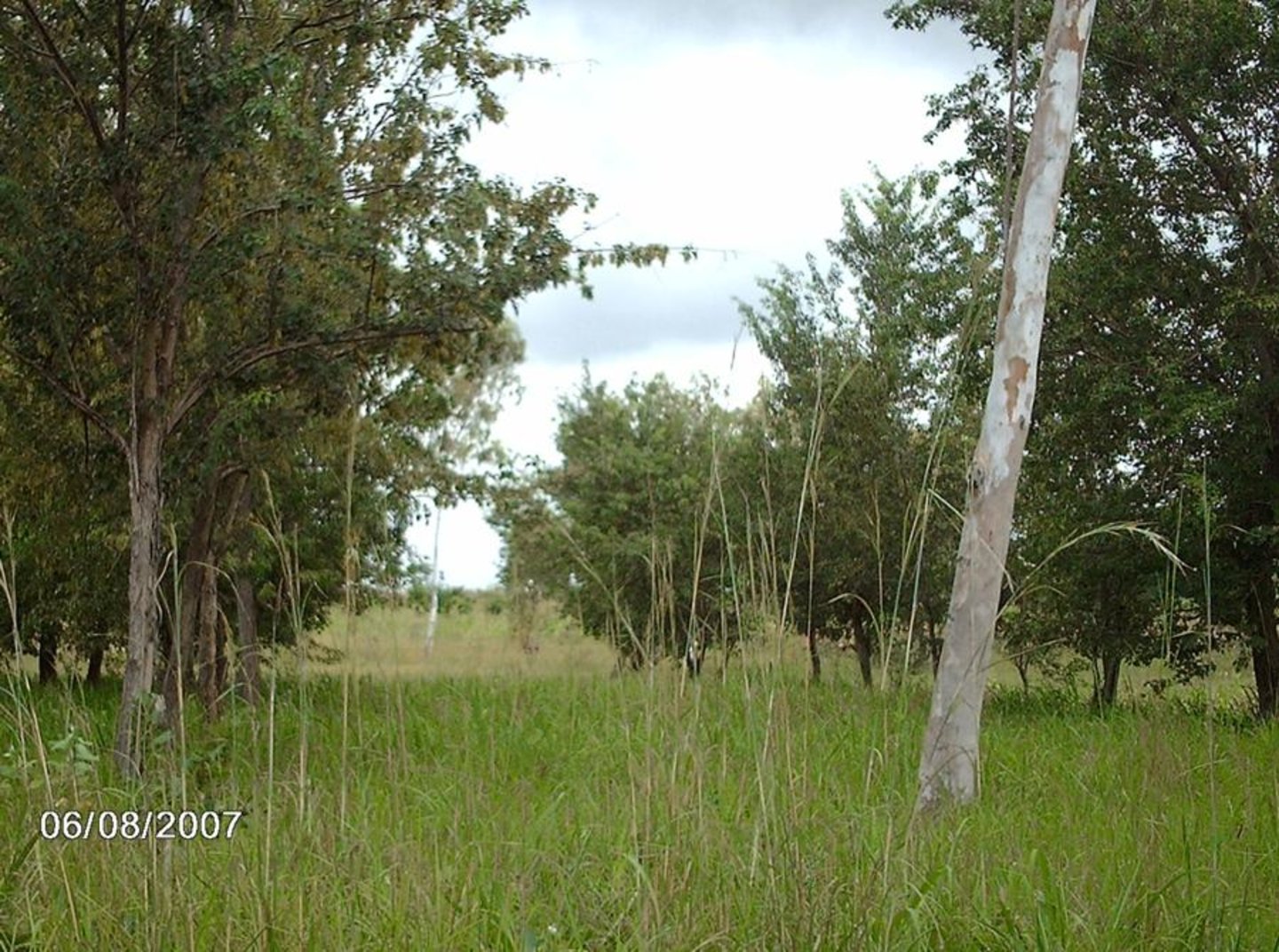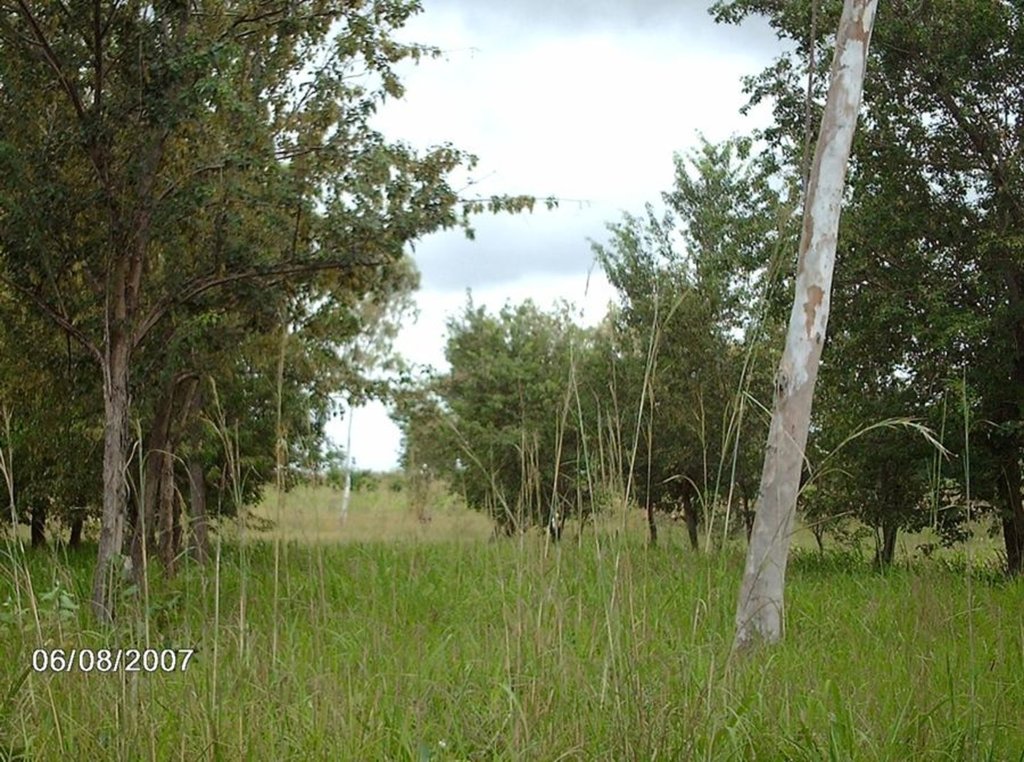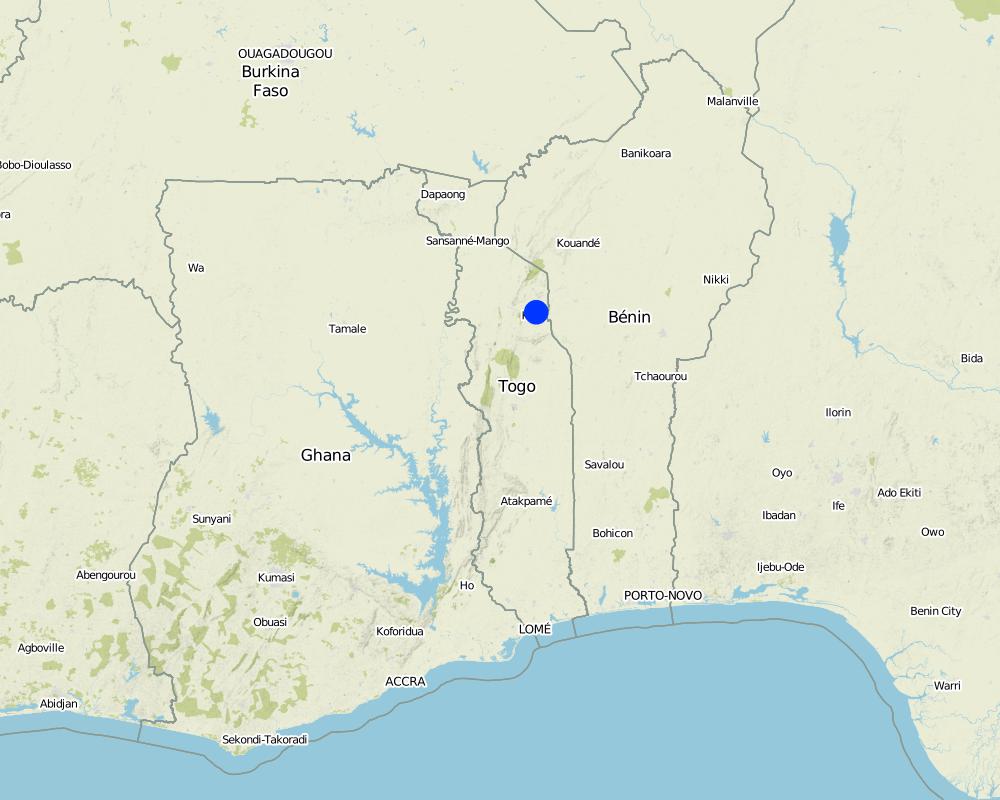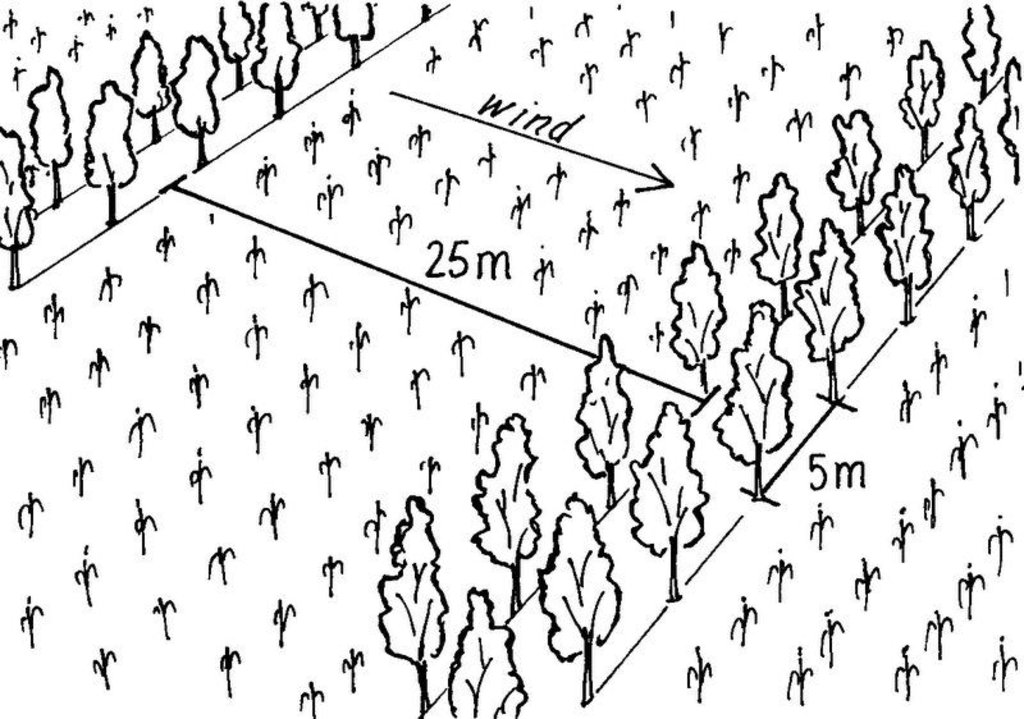Shelterbelts [多哥]
- 创建:
- 更新:
- 编制者: Unknown User
- 编辑者: –
- 审查者: Laura Ebneter, Alexandra Gavilano
Brise vents vivants / Hélim Rangou Tinn
technologies_1338 - 多哥
查看章节
全部展开 全部收起1. 一般信息
1.2 参与该技术评估和文件编制的资源人员和机构的联系方式
关键资源人
SLM专业人员:
Gbenonchi Mawussi
Ecole Supérieure d Agronomie, Université de Lomé (ESA UL)
多哥
有助于对技术进行记录/评估的项目名称(如相关)
Book project: SLM in Practice - Guidelines and Best Practices for Sub-Saharan Africa (SLM in Practice)有助于对技术进行记录/评估的机构名称(如相关)
Ecole Supérieure d'Agronomie, Université de Lomé (ESA) - 多哥1.3 关于使用通过WOCAT记录的数据的条件
编制者和关键资源人员接受有关使用通过WOCAT记录数据的条件。:
是
2. SLM技术的说明
2.1 技术简介
技术定义:
Shelterbelts made of leguminous trees and shrubs protect annual crops from wind erosion.
2.2 技术的详细说明
说明:
On the vast denuded plains of Pays Kabyé in northern Togo, barriers of leguminous trees (e.g. Cassia siamea or spectabilis; a medium sized tree growing between 10-20 m tall; Albizzia procera, Leucaena leucocephala) and shrubs (Cajanus cajan, Erythrina variegate) are established between fields cultivated with annual crops such as maize. The shelterbelts provide a good micro-climate and protect the crops against the counterproductive effects of wind speed such as wind erosion, soil water loss through evaporation and physical damage to crops. The shelterbelts’ effectiveness depends on their permeability, their spacing and the direction of planting in relation to the wind direction: A proportion of 40-50% of holes (openings, void) in relation to the total surface of the shelterbelt is desirable, and establishment of tree rows perpendicularly to the main wind direction is most effective. In order to reduce lateral turbulence the wind breaks need to reach a length of minimum 10 times their height. Shelterbelts protect 15-25 times their height on the leeward and 1-2 their height on the windward side. If the area to be protected is large, several wind breaks need to be established. The denser the shelterbelts are, the better the windbreaking effect, but the higher the competition with crops for nutrients, light and water. Frequent pruning helps to avoid too much competition and provides fuelwood. In case leguminous tree species are used, soil properties can be improved through nitrogen fixation and the provision of organic matter (leaves).
2.3 技术照片
2.5 已应用该技术的、本评估所涵盖的国家/地区/地点
国家:
多哥
区域/州/省:
Kara
有关地点的进一步说明:
Tchitchao
具体说明该技术的分布:
- 均匀地分布在一个区域
如果不知道精确的区域,请注明大致覆盖的区域:
- < 0.1 平方千米(10 公顷)
注释:
Total area covered by the SLM Technology is 0.8 km2.
Map
×3. SLM技术的分类
3.1 该技术的主要目的
- 改良生产
- 减少、预防、恢复土地退化
- 创造有益的经济影响
3.2 应用该技术的当前土地利用类型
同一土地单元内混合使用的土地::
是
具体说明混合土地使用(作物/放牧/树木):
- 农林业

农田
每年的生长季节数:
- 1
具体说明:
Longest growing period in days: 180 Longest growing period from month to month: May-October

牧场

森林/林地
注释:
Major land use problems (compiler’s opinion): adverse effects of wind speed on soil humidity and crop yield
Major land use problems (land users’ perception): breaking of corn stalks and therefore decline of crop yield
Future (final) land use (after implementation of SLM Technology): Mixed: Mf: Agroforestry
3.3 由于技术的实施,土地使用是否发生了变化?
由于技术的实施,土地使用是否发生了变化?:
- 是(请在技术实施前填写以下有关土地利用的问题)
同一土地单元内混合使用的土地::
是
具体说明混合土地使用(作物/放牧/树木):
- 农林业

农田
- 一年一作
- 乔木与灌木的种植
年作 - 具体指明作物:
- 谷物类 - 玉米
- Cassia siamea or spectabilis; a medium sized tree growing between 10-20 m tall; Albizzia procera, Leucaena leucocephala, Cajanus cajan, Erythrina variegate
采用间作制度了吗?:
是
如果是,说明哪些作物是间作的:
maize
3.4 供水
该技术所应用土地的供水:
- 雨养
3.5 该技术所属的SLM组
- 防风林/防护林带
3.6 包含该技术的可持续土地管理措施

植物措施
- V1:乔木和灌木覆盖层
注释:
Main measures: vegetative measures
Type of vegetative measures: aligned: -against wind
3.7 该技术强调的主要土地退化类型

土壤风蚀
- Et:表土流失
- Eo:场外劣化效应

水质恶化
- Ha:干旱化
注释:
Main type of degradation addressed: Et: loss of topsoil, Eo: offsite degradation effects, Ha: aridification
3.8 防止、减少或恢复土地退化
具体数量名该技术与土地退化有关的目标:
- 防止土地退化
- 减少土地退化
4. 技术规范、实施活动、投入和成本
4.1 该技术的技术图纸
技术规范(与技术图纸相关):
pacing between windbreak rows is 20-25 m. The row of windbreak can be of a single tree line, of double tree lines, etc. depending on wind speed and scope of protection. The in between tree line spacing is 5 m (see photo). Plant density can range from 100 – 200 plants/ha depending on the number of tree lines planed within a windbreak.
Location: Tchitchao. Préfecture de la Kozah
Technical knowledge required for field staff / advisors: high
Technical knowledge required for land users: moderate
Main technical functions: reduction in wind speed
Aligned: -against wind
Vegetative material: T : trees / shrubs
Number of plants per (ha): 40
Spacing between rows / strips / blocks (m): 20.00
Vertical interval within rows / strips / blocks (m): 5.00
Trees/ shrubs species: Cassia siamea or spectabilis, Albizzia procera, Leucaena leucocephala, Cajanus cajan, Erythrina var
作者:
Mats Gurtner, Centre for Development and Environment, University of Bern
4.2 有关投入和成本计算的一般信息
具体说明成本和投入是如何计算的:
- 每个技术区域
注明尺寸和面积单位:
0.8km2
具体说明成本计算所用货币:
- 美元
4.3 技术建立活动
| 活动 | 时间(季度) | |
|---|---|---|
| 1. | Determine the area to be protected and alignment of shelterbelts (1,2, or 3 lines of trees); rows to be established perpendicular to main wind direction) | during rainy season |
| 2. | Dig planting pits at a spacing of 2-3 meters | during rainy season |
| 3. | Planting of seedlings (when conditions are favourable) | during rainy season |
| 4. | Establish plant nursery | during rainy season |
| 5. | Regular irrigation of young tree seedlings after plantation; Weeding; Reduce density to a spacing 5 m between trees | during rainy season |
4.4 技术建立所需要的费用和投入
| 对投入进行具体说明 | 单位 | 数量 | 单位成本 | 每项投入的总成本 | 土地使用者承担的成本% | |
|---|---|---|---|---|---|---|
| 劳动力 | Labour | ha | 1.0 | 200.0 | 200.0 | 100.0 |
| 设备 | Tools | ha | 1.0 | 86.0 | 86.0 | 100.0 |
| 植物材料 | Seedlings | ha | 1.0 | 90.0 | 90.0 | 100.0 |
| 技术建立所需总成本 | 376.0 | |||||
| 技术建立总成本,美元 | 376.0 | |||||
注释:
Duration of establishment phase: 36 month(s)
4.5 维护/经常性活动
| 活动 | 时间/频率 | |
|---|---|---|
| 1. | Weeding (according to necessity / speed of regrowth) | according to necessity / speed of regrowth |
| 2. | Pruning to avoid shading effect on crops |
4.6 维护/经常性活动所需要的费用和投入(每年)
| 对投入进行具体说明 | 单位 | 数量 | 单位成本 | 每项投入的总成本 | 土地使用者承担的成本% | |
|---|---|---|---|---|---|---|
| 劳动力 | Labour | ha | 1.0 | 139.0 | 139.0 | 100.0 |
| 植物材料 | Seedlings | ha | 1.0 | 23.0 | 23.0 | 100.0 |
| 技术维护所需总成本 | 162.0 | |||||
| 技术维护总成本,美元 | 162.0 | |||||
注释:
Machinery/ tools: hand tools such as hoe, machete and measuring tape
the indicated costs apply per hectare unit
4.7 影响成本的最重要因素
描述影响成本的最决定性因素:
The monetary costs include the purchase of seeds, cuttings or nursery plants and labour for the preparation and planting. In certain circumstances, it is necessary to protect young trees against browsing and other damage.
5. 自然和人文环境
5.1 气候
年降雨量
- < 250毫米
- 251-500毫米
- 501-750毫米
- 751-1,000毫米
- 1,001-1,500毫米
- 1,501-2,000毫米
- 2,001-3,000毫米
- 3,001-4,000毫米
- > 4,000毫米
农业气候带
- 半湿润
Thermal climate class: tropics
5.2 地形
平均坡度:
- 水平(0-2%)
- 缓降(3-5%)
- 平缓(6-10%)
- 滚坡(11-15%)
- 崎岖(16-30%)
- 陡峭(31-60%)
- 非常陡峭(>60%)
地形:
- 高原/平原
- 山脊
- 山坡
- 山地斜坡
- 麓坡
- 谷底
垂直分布带:
- 0-100 m a.s.l.
- 101-500 m a.s.l.
- 501-1,000 m a.s.l.
- 1,001-1,500 m a.s.l.
- 1,501-2,000 m a.s.l.
- 2,001-2,500 m a.s.l.
- 2,501-3,000 m a.s.l.
- 3,001-4,000 m a.s.l.
- > 4,000 m a.s.l.
关于地形的注释和进一步规范:
Landforms: Also hill slopes and plateau/plains (both ranked 2)
5.3 土壤
平均土层深度:
- 非常浅(0-20厘米)
- 浅(21-50厘米)
- 中等深度(51-80厘米)
- 深(81-120厘米)
- 非常深(> 120厘米)
土壤质地(表土):
- 粗粒/轻(砂质)
- 中粒(壤土、粉土)
表土有机质:
- 中(1-3%)
如有可能,附上完整的土壤描述或具体说明可用的信息,例如土壤类型、土壤酸碱度、阳离子交换能力、氮、盐度等。:
Soil fertility: Medium
Soil drainage/infiltration: Medium (ranked 1) and good (ranked 2)
5.6 应用该技术的土地使用者的特征
生产系统的市场定位:
- 混合(生计/商业)
非农收入:
- 低于全部收入的10%
相对财富水平:
- 丰富
个人或集体:
- 个人/家庭
机械化水平:
- 手工作业
说明土地使用者的其他有关特征:
Land users applying the Technology are mainly Leaders / privileged
Population density: 200-500 persons/km2
1% of the land users are rich and own 100% of the land.
Off-farm income specification: these revenues are lower than for farmers who did not implement the wind breaks
5.7 应用该技术的土地使用者使用的平均土地面积
- < 0.5 公顷
- 0.5-1 公顷
- 1-2 公顷
- 2-5公顷
- 5-15公顷
- 15-50公顷
- 50-100公顷
- 100-500公顷
- 500-1,000公顷
- 1,000-10,000公顷
- > 10,000公顷
这被认为是小规模、中规模还是大规模的(参照当地实际情况)?:
- 小规模的
5.8 土地所有权、土地使用权和水使用权
土地所有权:
- 个人,有命名
土地使用权:
- 个人
6. 影响和结论性说明
6.1 该技术的现场影响
社会经济效应
生产
作物生产
木材生产
注释/具体说明:
And forest products (fruits)
生产区域
注释/具体说明:
Area occupied by tree hedges
收入和成本
农业投入费用
注释/具体说明:
Collection of seedlings
农业收入
工作量
注释/具体说明:
Extra work
其它社会经济效应
社会文化影响
SLM/土地退化知识
生态影响
土壤
土壤水分
注释/具体说明:
Through evaporation
土壤流失
注释/具体说明:
Loss of topsoil through wind erosion
生物多样性:植被、动物
害虫/疾病控制
注释/具体说明:
Nesting sites for predatory birds
减少气候和灾害风险
风速
其它生态影响
Shade for crops
6.2 该技术的场外影响已经显现
风力搬运沉积物
6.4 成本效益分析
技术收益与技术建立成本相比如何(从土地使用者的角度看)?
短期回报:
积极
长期回报:
积极
技术收益与技术维护成本/经常性成本相比如何(从土地使用者的角度看)?
短期回报:
积极
长期回报:
非常积极
6.5 技术采用
在所有采用这项技术的人当中,有多少人是自发的,即未获得任何物质奖励/付款?:
- 91-100%
注释:
100% of land user families have adopted the Technology without any external material support
There is no trend towards spontaneous adoption of the Technology
Comments on adoption trend: There is no growing trend of spontaneous adoption in the region since the windbreak technology is little known by most farmers
6.7 该技术的优点/长处/机会
| 编制者或其他关键资源人员认为的长处/优势/机会 |
|---|
|
Reduced wind speed How can they be sustained / enhanced? No exploitation or destruction of trees |
|
Soil conservation How can they be sustained / enhanced? Avoid burning the shelter belts |
|
Provision of forestry products How can they be sustained / enhanced? Reglementation of use of these products |
| High aestethic value of trees in the landscape |
|
Increased crop yield How can they be sustained / enhanced? Maintain the micro-climate generated by the shelter belts |
6.8 技术的弱点/缺点/风险及其克服方法
| 土地使用者认为的弱点/缺点/风险 | 如何克服它们? |
|---|---|
| Reduced area for cultivation of crops | establish the minimum of shelterbelts necessary for optimal protection |
| Reduced crop yields alongside shelterbelts (competition for nutrients, light, water) | avoid dense planting of trees and shrubs; frequently prune the trees |
| Shelterbelts provide habitat for vermins / pests (rats, insects) | frequently hunt these animals |
| Increased labour inputs |
7. 参考和链接
7.1 信息的方法/来源
7.2 参考可用出版物
标题、作者、年份、ISBN:
Care International au Togo. 1997. Agroforestry training and demonstrations in northern Togo. Final report to European Union B7-5040/93/21
标题、作者、年份、ISBN:
Louppe, D., H. Yossi. 1999. Les haies vives défensives en zones sèches et sub-humides d'Afrique de l'Ouest. Atelier Jachères, Dakar.
标题、作者、年份、ISBN:
Ariga, E. S., 1997. Availability and Role of Multipurpose Trees and Shrubs in Sustainable Agriculture in Kenya. Journal of Sustainable Agriculture 10:2/3, 25-35.
链接和模块
全部展开 全部收起链接
无链接
模块
无模块





